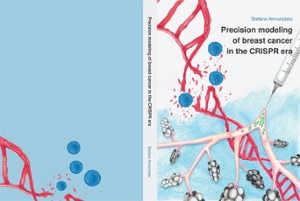Dissertation
Precision modeling of breast cancer in the CRISPR era
The molecular mechanisms that instigate a healthy cell to become malignant are fueled by (epi)genetic alterations in so-called driver genes.
- Author
- Annunziato, S.
- Date
- 16 January 2020
- Links
- Thesis in Leiden Repository

The molecular mechanisms that instigate a healthy cell to become malignant are fueled by (epi)genetic alterations in so-called driver genes. While the Holy Grail of precision medicine is to identify these genetic dependencies and to target them with specific compounds in a personalized fashion, this has proven a daunting task, as tumors are exquisitely characterized by genetic instability and a mutator phenotype. Genetically engineered mouse models (GEMMs) are uniquely suited for functional in vivo validation of genotype-phenotype relationships, as they enable in vivo assessment of de novo tumorigenesis in a mammalian organism with intact immune and stromal compartments upon perturbation of (combinations of) oncogenes and/or tumor suppressor genes. Somatic modeling of cancer using CRISPR technology in vivo proved to be a true game-changing tool, allowing for rapid functional validation of candidate cancer genes enrolling from forward genetic screens and catalogs of alterations in human tumors. In this work, I showed how CRISPR approaches were deployed to precisely engineer tumorigenic events in the mouse mammary gland for dissecting oncogenic cascades, unraveling new therapeutic vulnerabilities and mechanisms of therapy resistance in different breast cancer subtypes.
